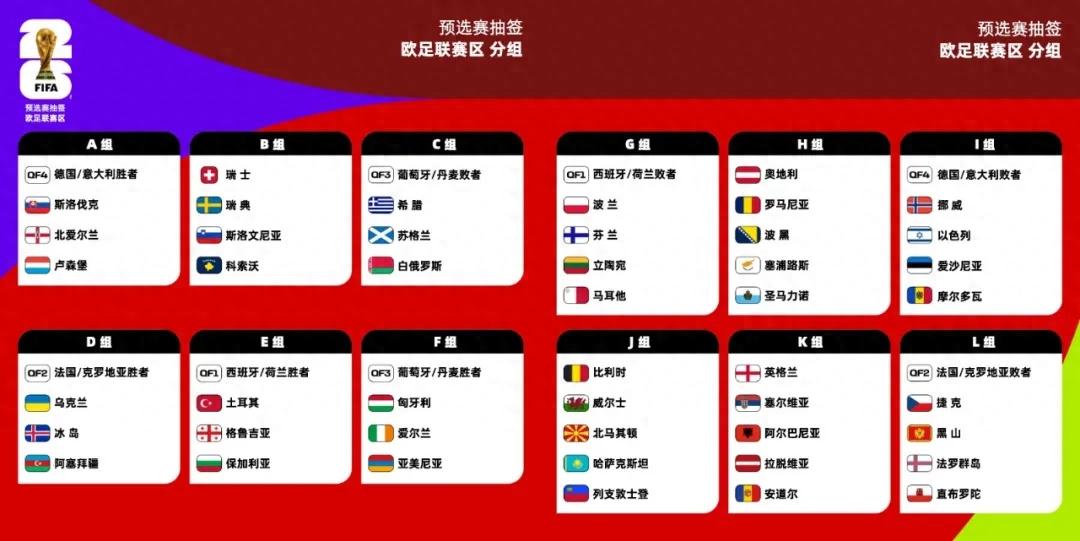The UEFA Nations League and the World European Pre-Full Collision Period are the most complicated and simplest draws in history

The reporter reported coldly On December 13, the draw for the European group stage of the 2026 World Preliminary Championship was the most complicated but also the easiest major draw in history. In addition to the principle of avoiding political confrontation and shortening the team's itinerary, the coordination of the schedule of the UEFA Nations League and the World Preliminary Tournament in March next year has been added, resulting in overly complex factors affecting the draw results. As many as eight of the 12 groups will not be able to determine the distribution of all teams in the group until the end of the UEFA Nations League A quarter-finals in March next year.
There are 16 qualifying places for the 2026 World Cup in Europe, with 54 UEFA football associations (excluding Russia, which are banned). However, due to the fact that in March 2025, as many as 28 teams will participate in the UEFA Nations League A 1/4 finals and 4 relegation play-offs, UEFA can only divide the qualifiers into 12 groups, with 6 groups of 4 teams in Group A-F and 5 teams in Group G-L of 6 groups. The qualifiers for the five teams will start in March next year, and the qualifiers for the four teams will start in September due to the collision with the UEFA Nations League in March and June next year.
The draw will be based on 12 teams, with 8 teams participating in the quarter-finals of the UEFA Nations League in Pot 1 and the rest of the teams in order of world ranking.

According to the results of the UEFA Nations League 1/4 finals in March next year (Italy VS Germany, Portugal VS Denmark, France VS Croatia, Spain VS Netherlands), the 4 winning teams and the losing teams of Portugal VS Denmark are divided into 5 4-team groups A, C, D, E, and F, and the other 3 losing teams are divided into 3 5-team groups of G, I, and L, and the 5 teams in Group G-L are in addition to the 3 teams participating in the UEFA Nations League 1/4 finals (Group G Spain VS Netherlands loser, In addition to Italy vs Germany loser in Group I and France vs Croatia loser in Group L, six teams from Malta (Group G), Austria (Group H), Belgium (Group J), Serbia, Latvia (Group K) and Gibraltar (Group L) participated in the UEFA Nations League relegation play-offs. These six groups will avoid the above nine teams in the schedule in March next year, and two teams in Group G, Group K and Group L will not be able to play in the World Preliminary Tournament at that time.
As early as the 2022 Qatar World Cup, the UEFA Nations League finals in which 4 teams participated collided with the World Preliminaries. However, at that time, it was only necessary to place these four teams in a group with fewer teams to avoid a collision period. However, there are as many as 28 teams in this collision period, more than half of the teams participating in the World Preliminaries, resulting in an unprecedented complexity in the draw process.
In contrast, the other avoidance principles are not surprising. The politically opposed Armenia/Azerbaijan, Gibraltar/Spain, Kosovo/Bosnia and Herzegovina, Kosovo/Serbia, and Ukraine/Belarus are not in the same group, Iceland and the Faroe Islands cannot be in the same group due to the cold climate, and Kazakhstan, Azerbaijan and Iceland can only have two teams in the same group at most due to their remote location. Iceland and Azerbaijan are in Group D, while Kazakhstan and Wales are in Group J, making them the two furthest groups of the World Preliminary Tournament.

As for the easiest, it is because of the European play-offs this time, the participating teams only need two games to qualify for the World Cup. In the qualifiers, the 12 group winners will qualify directly, the 12 group runners-up and the UEFA Nations League who did not qualify for the top two groups in the qualifiers, with a total of 16 teams, divided into four groups in March 2026, with two rounds of single-elimination matches to determine the four qualifying places. Given that the top 12 groups in the top three divisions of the UEFA Nations League (Spain, Germany, Portugal, France, England, Norway, Wales, Czech Republic, Romania, Sweden, North Macedonia and Northern Ireland) are almost all in the top two of the qualifiers, it means that Moldova and San Marino, the top teams in the two groups in the UEFA Nations League D, will almost certainly qualify directly for the play-offs.
San Marino, the lowest-ranked team in the world (210th), only needs to win two games in the play-offs in March 2026 to qualify for the World Cup? Although it is basically an impossible miracle, after all, the unique format of the play-offs has created the easiest and least played "super shortcut".
Euro 2020 and Euro 2024 have used a similar play-off format, with the top 16 teams in the UEFA Nations League who did not finish in the qualifying group divided into four groups and played two single-elimination rounds to determine the four qualifying places. The first of the four groups in the D class is in the same group, and North Macedonia is fortunate to participate in the European Championship for the first time in history; Euro 2024 play-offs will be won by 12 groups in the top three divisions of the UEFA Nations League, divided into three groups to compete for three qualifying places. In the end, the first team of the four groups in the UEFA Nations League C group was in the same group, and the Georgian team participated in the European Championship for the first time in history.



Wonderfulshortvideo
User PlaymakerHub has posted a video.








 Links
Links
 Contact
Contact
 App
App


